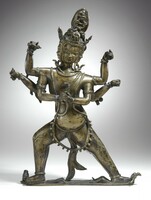Vajrakila Page - Updated

Vajrakila, also known as Vajrakilaya or Vajra Kumara (Vajra Youth) , is the activity aspect from the set of Eight Herukas (Tib.: ka gye) of the Mahayoga Tantras of the Nyingma Tradition of Tibetan Buddhism and a principal meditational deity for both the Nyingmapa and Sakyapa, later taken up by the Jonang and many of the various Kagyu Traditions. The study of Vajrakila can be divided into three major subjects: (1) the early Nyingma and Sakya Traditions, (2) the later 'Revealed Treasure' (Terma) traditions and (3) the Purba Drugse Chempa of the Bon Religion.
See the updated Vajrakila Main Page.
The unique iconographic feature of Vajrakila is the three-sided peg (purba) that is held, pointed downward, with the two principal hands at the heart. Typically Vajrakila has three faces, six hands, four legs and wide outstretched wings behind. He embraces the consort Dipta Chakra who has one face, two hands and two legs.
There are two basic forms of the deity Vajrakila. The first is as described above with the lower body having four legs. An alternate to this is with a lower body shaped as a triangular peg with three blades (purba). In the 'Revealed Treasure' Tradition a variety of other forms developed such as the Nine-headed Vajrakila. There are dozens and dozens of 'Revealed Treasure' Traditions for Vajrakila and it can probably be said that he is the most popular meditaional deity of the Nyingma Tradition. Another deity form sometimes confused for Vajrakila is the deity Guru Dragpur, a form of Padmasambhava, an early Buddhist teacher in Tibet. Numerous wrathful meditational deities and protectors hold the purba (peg) as a hand attribute but they should not be confused with Vajrakila. Examples of these other deities are: Guru Dragpo, Shri Devi Dudsolma of the Naropa tradition, etc.
